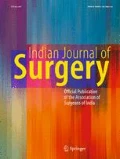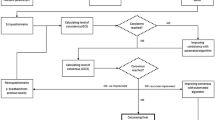Abstract
Virtual reality (VR) surgical simulation is the latest addendum to the surgical skills laboratory, and it makes inferences about levels of surgical performance by measuring motion, efficiency, errors and time taken to perform a task. The high costs associated with acquiring these simulators have limited the universal availability of such trainers across institutions in our country. This study aims to validate an indigenously designed Indian virtual reality simulation-based trainer as a valuable tool in surgical training. The performance parameters of ten laparoscopic basic surgical skill tasks were analysed. These included deviation from the desired path (error), total distance traversed in performing the task (distance in mm) and total time taken to complete the task (task completion time in seconds). One hundred seventy tasks performed by novices and 100 by experts were included for comparative analyses. Significant difference was found with regard to distance traversed by instruments (p value < 0.001) and total time for completion of a task (p value < 0.001) both of which were lesser in the group of tasks performed by experts. The distance traversed by instruments were higher amongst novices compared with experts. The task completion time was higher amongst novices in all the exercise except that of peritoneal layer peeling. These virtual reality-based simulators are a valid tool in surgical training that offer a wide range of exercises comparable to conventional trainers. These trainers analyse performance of the user as well as distinguish their level of expertise. This quality provides the added benefit of objective feedback of performance, thereby enabling a trainee to progress towards becoming a highly skilled laparoscopic surgeon.




Similar content being viewed by others
References
Satava RM, Gallagher AG, Pellegrini CA (2003) Surgical competence and surgical proficiency: definitions, taxonomy and metrics. J Am Coll Surg 196(6):933–937
De Montbrun SL, MacRae H (2012) Simulation in surgical education. Clin Colon Rectal Surg 25:156–165
Cameron JL (1997) William Stewart Halsted. Our surgical heritage. Ann Surg 225(5):445–458
Seymour NE (2008) VR to OR: a review of the evidence that virtual reality simulation improves operating room performance. World J Surg 32:182–188
Yiannakopoulou E, Nikiteas N, Perrea D, Tsigris T (2015) Virtual reality simulators and training in laparoscopic surgery. Int J Surg 13:60–64
Figert PL, Park AE, Witzke DB, Schwartz RW (2001) Transfer of training in acquiring laparoscopic skills. J Am Coll Surg 193:533–537
Crothers IR, Gallagher AG, McClure N, James DT, McGuigan J (1999) Experienced laparoscopic surgeons are automated to the “fulcrum effect”: an ergonomic demonstration. Endoscopy. 31:365–369
Gallagher AG, McClure N, McGuigan J, Crothers I, Browning J (1999) Virtual reality training in laparoscopic surgery: a preliminary assessment of minimally invasive surgical trainer virtual reality (MIST VR). Endoscopy 31:310–313
Bansal VK, Raveendran R, Misra MC, Bhattacharjee H, Rajan K, Krishna A, Kumar P, Kumar S (2014) A prospective randomized controlled blinded study to evaluate the effect of short-term focused training program in laparoscopy on operating room performance of surgery residents (CTRI /2012/11/003113). J Surg Educ 71(1):52–60. https://doi.org/10.1016/j.jsurg.2013.06.012
Botden SM, Jakimowicz JJ (2009) What is going on in augmented reality simulation in laparoscopic surgery? Surg Endosc 23:1693–1700
Bansal VK, Tamang T, Misra MC, Prakash P, Rajan K, Bhattacharjee HK, Kumar S, Goswami A (2012) Laparoscopic suturing skills acquisition: a comparison between laparoscopy-exposed and laparoscopy-naive surgeons. JSLS 16(4):623–631. https://doi.org/10.4293/108680812X13462882737375
Mohtashami F, Dadelszen P, Allaire C (2011) A surgical virtual reality simulator distinguishes between expert gynecologic laparoscopic surgeons and perinatologists. J Soc Laparoendosc Surg 15:365–372
Pitzul KB, Grantcharov TP, Okrainec A (2012) Validation of three virtual reality fundamentals of laparoscopic surgery (FLS) modules. Stud Health Technol Inform 173:349–355
Gurusamy KS, Aggarwal R, Palanivelu L, Davidson BR (2009) Virtual reality training for surgical trainees in laparoscopic surgery. Cochrane Database Syst Rev 21(1):CD006575. https://doi.org/10.1002/14651858.CD006575.pub2
Munz Y, Almoudaris AM, Moorthy K, Dosis A, Liddle AD, Darzi AW (2007) Curriculum-based solo virtual reality training for laparoscopic intracorporeal knot tying: objective assessment of the transfer of skill from virtual reality to reality. Am J Surg 193(6):774–783
Ericsson KA (2004) Deliberate practice and the acquisition and maintenance of expert performance in medicine and related domains. Acad Med 79:S70–S81
Author information
Authors and Affiliations
Corresponding author
Ethics declarations
Conflict of Interest
The authors declare that they have no conflict of interest.
Additional information
Publisher’s Note
Springer Nature remains neutral with regard to jurisdictional claims in published maps and institutional affiliations.
Electronic supplementary material
ESM 1
(DOCX 528 kb)
Rights and permissions
About this article
Cite this article
Aspari, A.R., Ramesh, V. & Lakshman, K. An Indigenous Virtual Reality-Based Simulator—a Tool in Surgical Training. Indian J Surg 83, 176–182 (2021). https://doi.org/10.1007/s12262-020-02347-z
Received:
Accepted:
Published:
Issue Date:
DOI: https://doi.org/10.1007/s12262-020-02347-z




